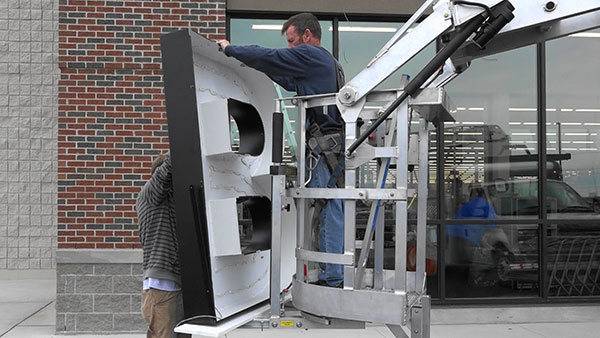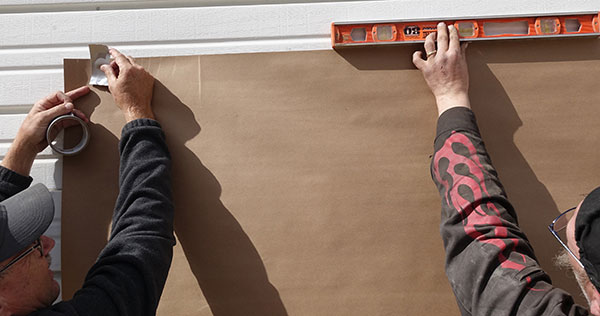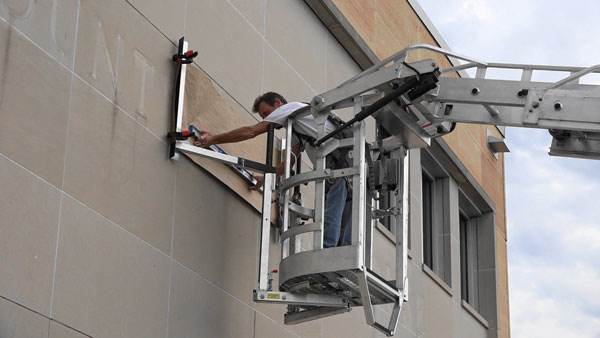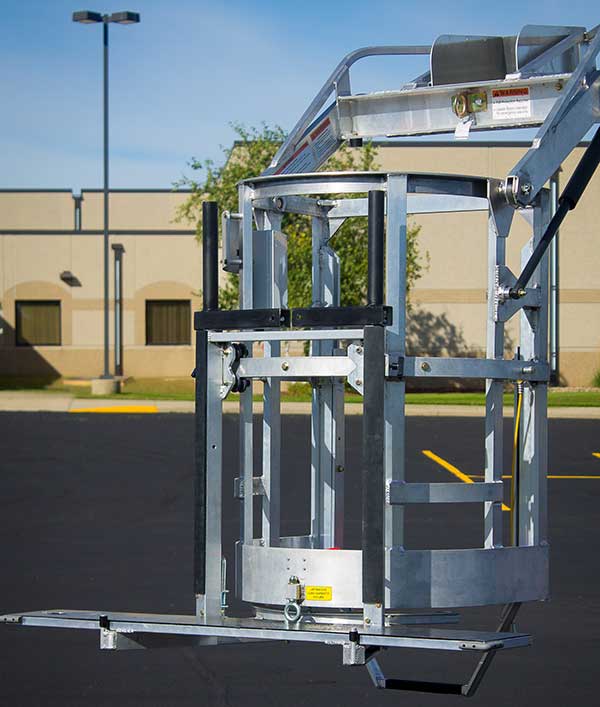Dividing and Conquering
(Let’s Do the Math)
The Van Ladder is a one-person aerial workshop, but that’s not to say you shouldn’t send two people on installs. We’ve talked with plenty of sign companies that utilize two-person teams, regardless of the size of the job, with excellent reasons for doing so.
Does the Van Ladder lose its benefits over a two-person bucket when there’s more than one installer on the job? Not at all. But for these companies, dividing and conquering might mean separating the aerial work from the ground-level responsibilities so both technicians can be productive and efficient. To make the point, let’s assume you’re installing a set of five-foot electric channel letters on the side of a big-box store. Let’s compare the Van Ladder with a big bucket truck with a two-person platform.
Hanging the pattern
Two-person platform:
With a two-person platform, there’s plenty of room for both installers to go up with the pattern—Installer #1 holding the paper, and Installer #2 measuring, leveling and taping. It’s not until the pattern is in place that the team can split up—one to drill the holes, and the other to begin uncrating the letters.
Van Ladder with the Chariot Bucket:
We’ve developed pattern arms that attach to our rotating fork system. The pattern arms do precisely what the Installer #1 does in the two-man bucket—hold the pattern. These arms are adjustable up and down, in and out, left and right. That means one of your installers can be in the air while the other works from the ground—uncrating the channel letters, preparing the wiring and conduit, and staging the sign for easy access to the bucket. So by the time the pattern is up, the first letters are ready to go.
Installing the letters
Two-man bucket:
Again, the two-man bucket easily accommodates both installers—Installer #1 resting the cargo atop his boot with hands engaged in holding the channel letter in place for Installer #2, who lines up the holes and inserts the screws. Couldn’t installer #1 go up by himself? Sure, but it’s hard to line up the holes—peeking behind a five-foot letter—when the cargo is resting on your boot. Plus, what prevents the channel letter from falling to the ground if it slips off the boot and one hand is holding the drill?
Van Ladder with Chariot Bucket:
The Chariot Bucket has lower forks that slide out to receive a rubber-coated platform. Once the channel letter is in position on the platform, securement braces slide over the top of the letter holding it in place, giving the installer a free hand to operate the lift. As the bucket nears its intended destination, the platform can be rotated to square the letter to the wall. The installer then snugs the platform close enough to the wall that the channel letter can’t fall. Now it’s safe to remove the securement braces. Since the letter is still resting securely on the platform, the installer has both hands free to work. Now, rather than standing in the bucket with a letter on his toe, Installer #2 is on the ground, continuing to prep the letters, and then loading the platform for Installer #1, keeping him moving. Once all the letters are prepped, Installer #2 can run inside and pull wires or clean up the job site or start prepping for the next project. The idea is to divide and conquer—one person handling the aerial work and the other tackling the ground-level functions. On a recent installation, a technician estimated that the Chariot Bucket saved him and his partner (4) man-hours on an installation involving (10) 5’ channel letters. That’s the benefit of dividing and conquering.
Doing the math
For easy calculation, let’s assume a new Van Ladder costs $100,000, while a nicely accessorized 60’ bucket truck with a two-person platform costs $250,000 (To be clear: We’re not saying you don’t need the big truck for much of your work, but maybe not the 4’x10’ cabinets or the 12’ raceways or the 5’ channel letters).
It’s time to do the math.
Let’s say you’re spreading the cost of that big truck over six years. At current interest rates, your payments on that $250,000 truck will be in the neighborhood of $4,000 per month. If you can keep that truck busy 8 hours per day, five days a week, the bank payment alone would amount to $23 per hour. Now, how about gas, oil changes, and the occasional repair? Or, how about uncooperative weather, holidays, vacations, project delays, and all the other stuff that might keep that truck in the yard on Monday thru Friday? It’s no stretch to discover that your actual cost on that truck is somewhere in the neighborhood of $35 per hour.
Van Ladder has the lowest cost of ownership in the industry (after the purchase). But for this example, let’s assume that our hourly cost of ownership bore the same ratio to the big truck as their purchase price, or 40% ($100,000/250,000). That would place the Van Ladder’s cost of ownership at a more manageable $14 per hour.
Now, let’s look at your installers. How much do they cost? When you add up their pay, benefits, payroll taxes, work comp insurance, and potential unbillable hours, you might discover that you need $50 of billable hourly revenue—just to cover your labor.
If two installers traveling around in a two-man bucket were to tackle the above referenced installation in (8) hours, here’s what the math would look like for job costing:
$35 (Truck) + $50 (Installer #1) + $50 (Installer #2) = $135 x 8 (Hrs.) = $1,080
If my installer friend is right, and two guys with a Van Ladder could accomplish the job in 6 hours, here’s the amended calculation:
$14 (Truck) + $50 (Installer #1) + ($50 Installer #2) = $114 x 6 (hours) = $684
In this fictitious example, the Van Ladder option represents a cost savings of 37%, which goes straight to the bottom line. Also, the time savings would provide more capacity for your team to complete more jobs—added revenue.
But we don’t expect you to take our word for this divide and conquer philosophy based on a fictitious example. We’re prepared to prove it.
If you’re in the market for a truck, let us bring a Van Ladder with the new Chariot Bucket to one of your installations.
You can let your own installers verify the value of having a one-man aerial workshop. We’re confident they will. As you’ve seen on our videos, we’ve witnessed it over and over.
This is shaping up to be a crazy year. We’re all trying to do 12 months of work in nine. We believe the Van Ladder can help you get it all done. Give us a call.






